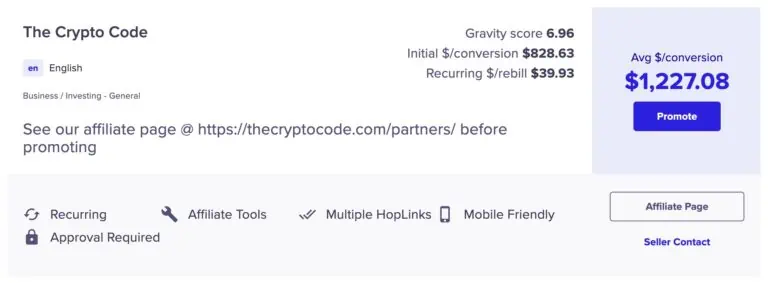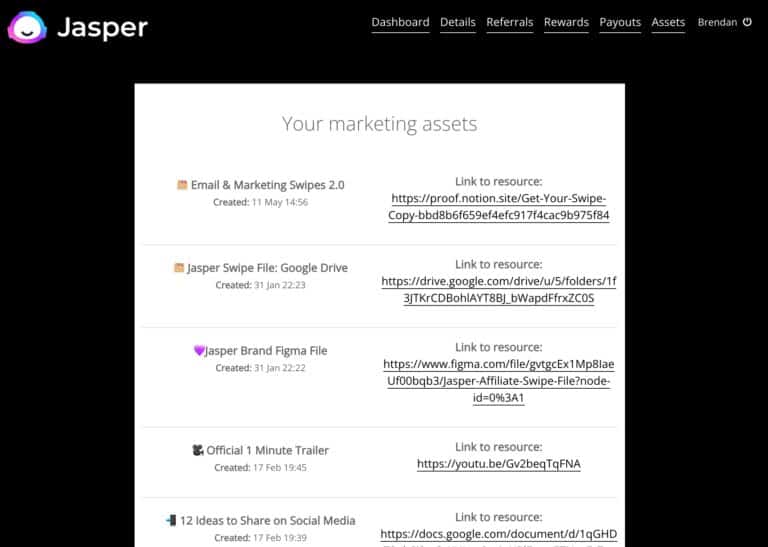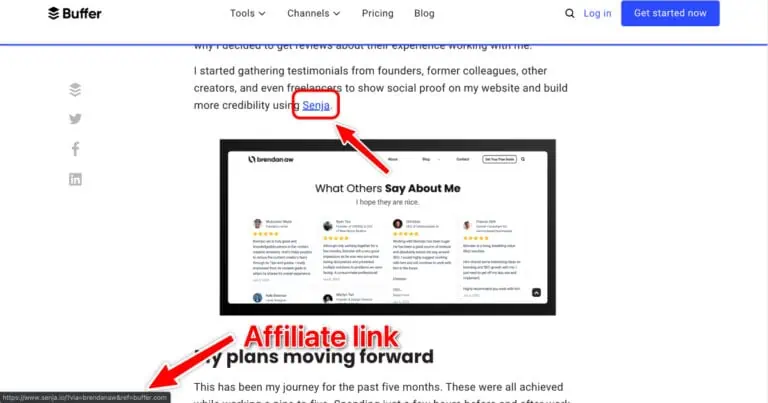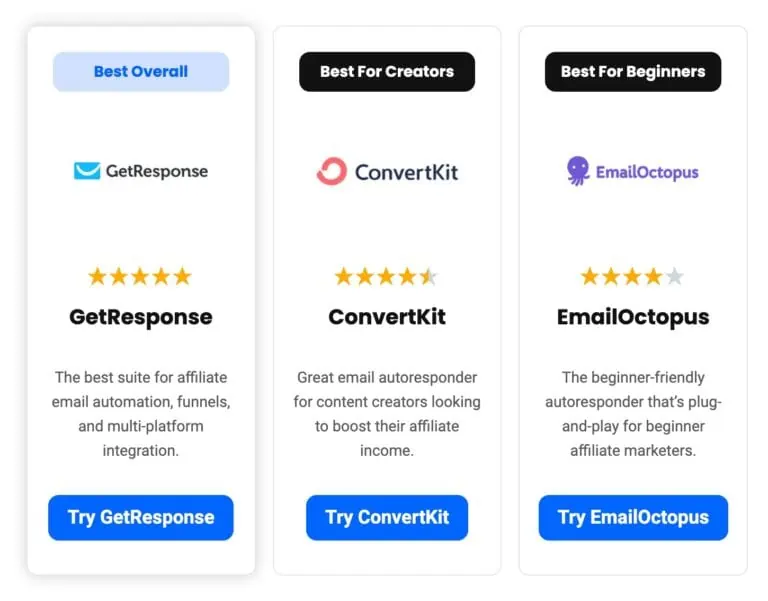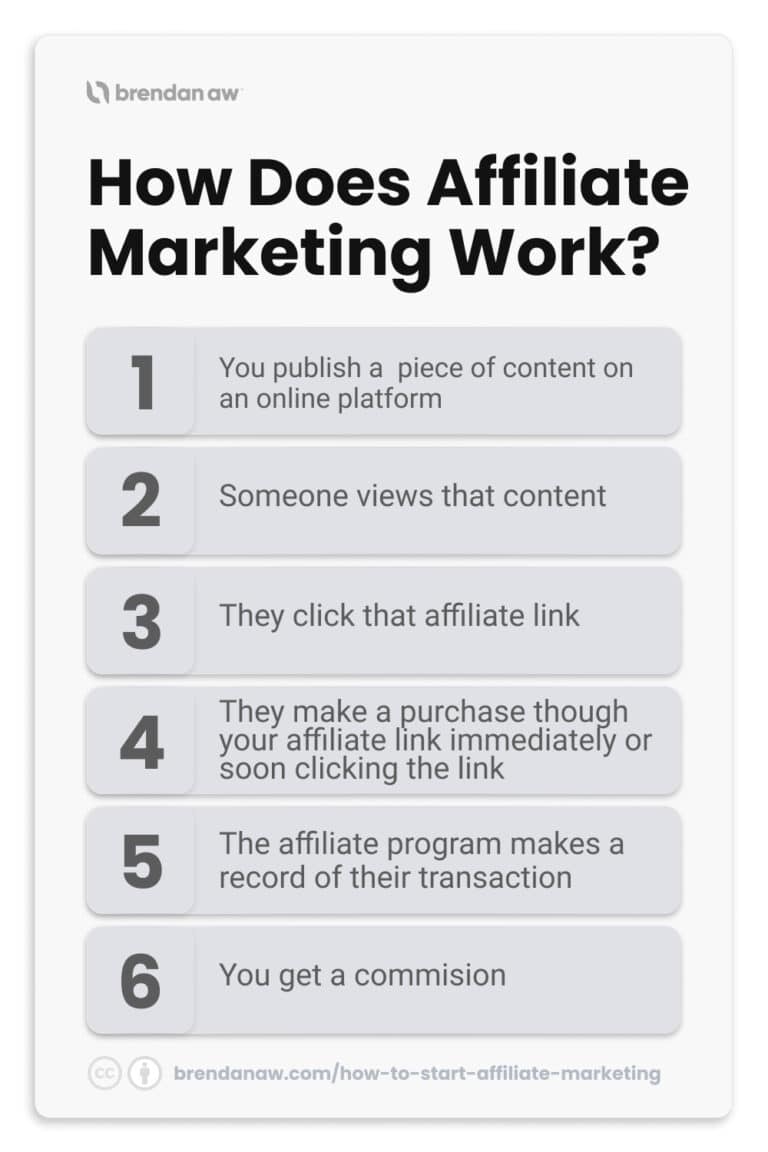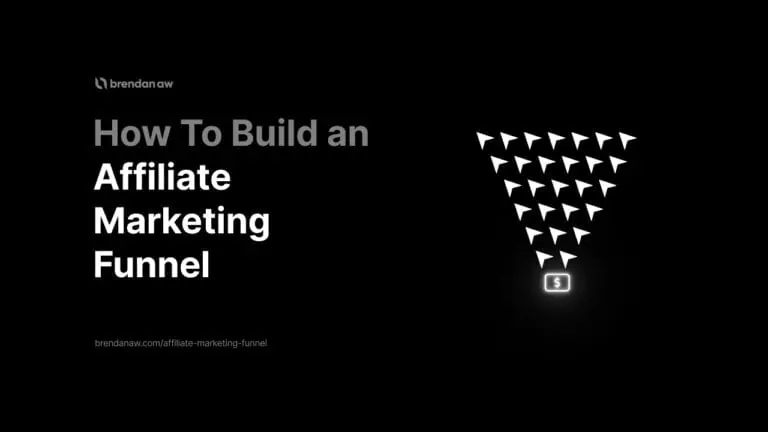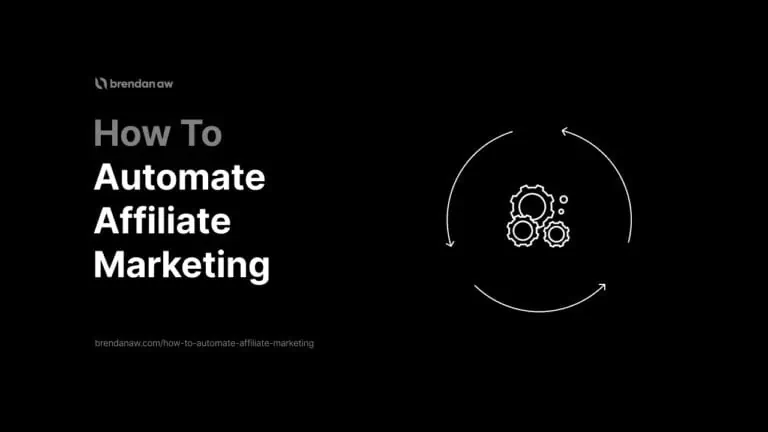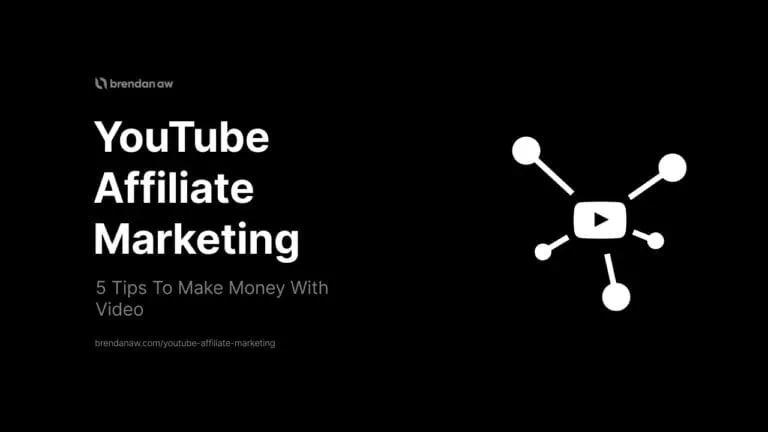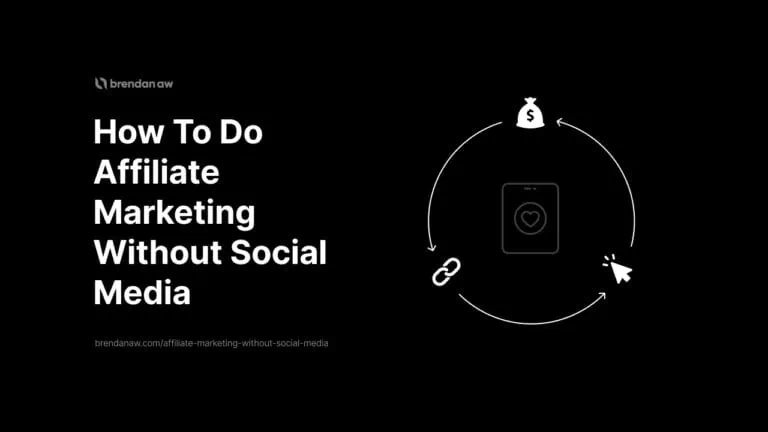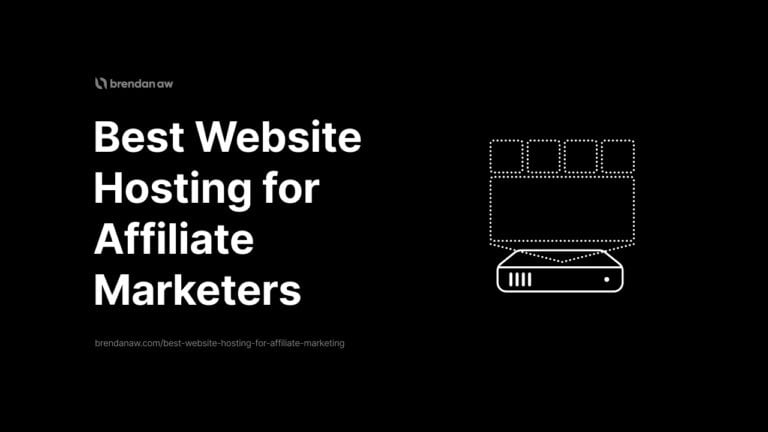Affiliate marketing is not a get-rich-quick scheme.
But…
It’s one of the best ways to make passive income.
You don’t even need a lot of experience to start.
Planning to quit your 9 to 5?
With a little bit of research and the right attitude…
You can launch your affiliate marketing business today and start making bank.
I want to help you get there.
So…
Here’s a step-by-step guide on how to start affiliate marketing.
What Is Affiliate Marketing?
Affiliate marketing is a revenue-sharing business model where an affiliate earns a commission for recommending a company’s products or services.
Simply put…
You earn a percentage of the sale when a customer purchases through your affiliate link.
This can range anywhere between:
- 3 to 30% for most physical products
- As high as 70% for digital products such as software and online courses
Affiliate marketing is now a $14.3 billion global industry projected to grow year by year.
There are more than 11,000 affiliate programs in the US alone.
How To Start Affiliate Marketing
Here are the eight steps on how to start affiliate marketing:
- Choose a Niche
- Pick a Content Distribution Platform
- Join Affiliate Programs and Networks
- Create Affiliate Content
- Drive Traffic to Your Affiliate Links
- Manage Your Affiliate Links
- Track Your Affiliate Performance
- Improve Conversion Rate Optimization (CRO)
1. Choose a Niche
Picking the right affiliate marketing niche is the most important step.
Pick the right one and make money in a few weeks.
The wrong one may set you back years for nothing.
The right traffic source and marketing strategy hinge on two things:
- What type of products you’re promoting
- Who is your target market
Be as specific as possible.
Target a small market segment rather than attempt to penetrate an entire industry.
I know how tempting it is to be broad and promote as many different products as you can…
But you’ll soon find this is counterintuitive.
Think of it this way:
If you target everyone, you target no one.
But if you run your business as it pleases the algorithm gods…
Well, that’s a different story.
Here are some things you need to consider when choosing a niche:
Lean Into Your Passions / Interests
- What are you good at?
- What do you like doing?
These two things will make running your affiliate marketing business easier and much more enjoyable.
Having some knowledge about the niche also helps lessen your learning curve.
A quicker way to set up your business and implement effective marketing strategies.
Research Your Competitors
Find out what other affiliates in your niche are doing – especially the highly successful ones.
- Where are they promoting their affiliate links?
- How do they structure their content?
What’s working for them will likely work for you too.
But… Don’t just copy their strategy.
You’ll need to find your unique selling point (USP) if you want to stand out and corner a decent size of the market.
Assess Market Demand
Speaking of the market, you do need to figure out how big your niche is.
This dictates how much you can earn from promoting affiliate products.
For example, crocheting may be a growing community…
But crocheting with rare yarn or fibers is a significantly smaller subset of that market, so it may not be a profitable niche.
Take the fidget spinner, for instance.
It was all the rage for about six months before it promptly fell off the face of the earth.
Now tons of suppliers are stuck with useless inventory.
If you still want to get into this niche, I’d recommend something timeless like Legos and Barbies.
Otherwise, maybe stick with something that people use every day, like good ol’ household supplies.
2. Pick a Content Distribution Platform
The next step is to decide on your traffic source (a.k.a where you want to promote your affiliate products).
This can be:
- A website or blog
- Visual search engines like YouTube and Pinterest
- Social media platforms like TikTok, Instagram, and Facebook
As a beginner, I recommend starting with one platform and mastering it before diversifying your traffic sources.
Two things to consider when picking a content platform:
- Which platforms do your target audience use the most?
- Which platforms are you most familiar with?
I personally prefer a website over social media.
It gives me more control and freedom over my content and marketing efforts.
It’s also scalable and evergreen.
I can grow my business exponentially and make money for several years.
However, running your own website requires startup and running costs and a bit of technical know-how…
Or money to pay someone to do it for you.
Here’s a brief overview of what you need to do to start a blog for your affiliate marketing business:
- Get web hosting: It’s a service that stores your website files and makes them available for online viewing. The best website hosting will depend on your needs and preferences. For example, Bluehost is beginner-friendly and easy to use, while Cloudways offers more flexibility.
- Choose a website-building platform: This is where you can publish content and promote your affiliate links. You can also use your website to build an email list, link to your social media platforms, or even promote your own products or services. WordPress is my favorite web builder out there. It’s user-friendly, scalable, and affordable.
- Customize your website: It’s important to have strong and consistent branding, high-quality visuals, compelling and value-adding content, and a user-friendly and responsive interface.
If you want to diversify your traffic sources or don’t have the money to launch a website…
Building a brand on social media is an excellent strategy.
If you go down this route, here are a couple of things to keep in mind:
- Video is the preferred content format of the future.
- Organic engagement is key.
Social media also lets you tap another income stream…
Ad Revenue.
Here, you can make money off of ad revenue once your account meets certain criteria.
For example:
- YouTube: 500 subscribers and 3,000 watch hours
- TikTok: 10,000 followers and 100,000 video views
- Facebook: 5,000 followers and 60,000 watch hours
- Instagram: 10,000 followers and a Business or Creator account (for US residents only)
- X (Formerly Twitter): 500 followers, 5 million organic expressions, and an X Premium account
Once you’re accepted, you can profit from every single person who views and engages with your content regardless of whether they click your affiliate links.
3. Join Affiliate Programs and Networks
There are two ways to find affiliate programs:
- Look up brands you want to work with online and check if they have affiliate programs.
- Sign up to affiliate networks to access hundreds of brands at once.
Amazon Associates is the largest affiliate marketing network with over 20% of the market share…
But they offer the lowest commission rates at 10%.
At the other end of the spectrum…
ClickBank offers commission rates of up to 70%, translating to over $1,000 for some products.
Amazon products are mass market.
So while you can only earn a tiny commission off of each sale…
The high volume of sales can make up for it.
You also earn a commission on the customer’s total purchase.
For example…
If I buy a product through your affiliate link and add 10 other items to my cart within 30 days, you’ll also make a commission off of those products.
Meanwhile,
Clickbank products are mainly high-ticket digital products.
This means the market is significantly smaller…
But you can make bank with just a couple of sales.
Digital products also often mean recurring commissions since many of these products are subscription-based.
These programs also offer dedicated affiliate managers to support all your enquiries.
Some even give marketing assets like:
- Sales copy
- Ad creatives
- Email swipes
Considering both?
I have great news…
You don’t have to limit yourself to just one affiliate program.
While some brands may have clauses against promoting competing products…
You’re free to sign up for as many affiliate programs as you want.
Here are some factors to consider when choosing an affiliate program:
- Commission rate
- Product demand
- Cookie period
- Affiliate support
4. Create Affiliate Content
Here are some types of affiliate content you should create to promote your links:
- Product reviews: You can do a deep dive into one product and promote your links through your blog post.
- Email newsletters: Build an engaged email list and send targeted value-adding emails recommending affiliate products to your subscribers.
- Tutorials: The best way to provide value to your target audience is by offering a free step-by-step guide. This can be a detailed overview of a specific topic or instructional material for your affiliate product.
- Landing Pages: An affiliate landing page is the last piece of content your leads will see before they proceed to the affiliate product page and hit the checkout button. As such, it needs to be optimized for a single CTA: some creative variation of “BUY”.
- Videos: Whether it’s 8-minute YouTube videos or short-form content on TikTok… Video has the power to not only convey information but better connect with an audience.
Affiliate marketing content isn’t some special sauce…
But it does incorporate more tactics like:
- Copywriting
- Conversation rate optimization (CRO)
- User interface design
These have the single objective of getting more affiliate link clicks.
5. Drive Traffic to Your Affiliate Links
Once you have a decent content database with affiliate links… the next step is to drive traffic to them.
There are many ways to do this, including:
- SEO
- Email campaigns
- Paid ads
- Social media
- Guest posting
- Forums
SEO
Search Engine Optimization (SEO) is about improving your content visibility and ranking on search engines like Google.
It’s also one of the best free traffic sources for affiliate marketing if DIYed.
On-page and technical SEO focuses on activities inside your website.
Examples of on-page SEO:
- Keyword optimization: Including relevant keywords naturally within the content.
- Internal linking: Linking to other relevant pages within your website to help distribute page authority and guide users.
- Title tags: Crafting descriptive and relevant titles for each page.
- Header Tags (H1, H2, etc.): Structuring content with proper header tags.
Examples of technical SEO:
- Website speed: Optimizing server performance, using content delivery networks (CDNs), and compressing images to improve load times.
- Mobile optimization: Ensuring the website is mobile-friendly and responsive on various devices.
- Structured Data/Schema Markup: Coding langauge that helps search engines understand the context of your content.
- XML sitemaps: Creating and submitting a sitemap to search engines to help them understand the structure of your site.
Off-page SEO focuses on activities outside of your website.
Examples of off-page SEO:
- Backlink Building: Engaging in activities like guest posting, link insertions and link exchanges to earn backlinks.
- Influencer outreach: Collaborating with influencers in your industry to promote your content.
- Digital PR: Contribute thought-leadership quotes to journalists on HARO and Help a B2B Writer to get links.
Email Marketing
Email marketing is usually the best way to get the most conversions on your affiliate links…
I’m going to assume you’ve already started a newsletter and have subscribers but haven’t gotten around to monetizing it.
There are tons of different setups…
And it’s impossible to dive into detail now.
But the general idea is to send a series of emails with content appropriate for every stage of the affiliate marketing funnel.
The goal is to send them to your affiliate offer eventually.
This whole process can be automated with affiliate marketing autoresponders.
This works exceptionally well because your audience is already warmed up and prime for a purchase…
But it’s also one of the most difficult processes, as you don’t magically end up with subscribers.
Paid Ads
What is the fastest way to promote your affiliate products?
Paid traffic.
Starting an affiliate marketing business involves many steps…
But paid ads can give you a head start…
It drives traffic to your affiliate links immediately.
But be warned…
Traffic goes as fast as it comes.
Once you stop…
That’s it.
I recommend only using paid ads once you have a sustainable organic SEO strategy in place.
Social Media
Given that more than half of the world’s population is on one or more social media platforms…
Social media may be one of the easiest ways to start affiliate marketing without a website.
You can drive solid traffic as long as you:
- Target the right audience.
- Create useful content consistently.
- Collaborate with other creators for cross-promotion.
But here are some disadvantages of using only social media platforms for affiliate marketing:
- Platform dependency: You’re at the mercy of the social media platform’s rules and algorithms.
- Lack of control: Unlike a website… You don’t control or own your content. Your profile can also be suspended or deleted without notice. Say goodbye to your affiliate commissions overnight.
- Limited SEO benefits: Social media posts typically don’t rank in search engines the same way website content does. This limits your organic reach and you can’t target commercial keywords like “X Best [Product Type].”
It’s definitely possible…
But I recommend starting a blog and using social media platforms as your secondary content distribution channels.
Guest Posts
Guest posting is a great way to connect with another platform’s audience.
This is a link building strategy where you reach out to other websites offering to write a blog post in exchange for a backlink…
These links are usually directed to:
- Your homepage
- Relevant articles on your blog
- Other websites
But you can include your affiliate links on some rare occasions.
Check out my guest post on Buffer where I wrote about how my creator startup made 4-Figures in 5 months while working a 9 to 5.
Notice how I could include my affiliate link while writing about getting more testimonials with the tool Senja.
Don’t bet on this happening all the time.
It’s unlikely.
Focus on contributing posts and redirecting their readers to your own affiliate content.
Forums
Online forums like Quora and Reddit are some of the best places to get eyes on your affiliate links.
These people are already experiencing problems and desperately trying to find solutions.
The goal here is to provide direct and comprehensive answers while subtly mentioning affiliate products.
There is no reason they won’t click if your recommendations help them solve issues:
- Faster
- Cheaper
- Easier
Don’t miss the opportunity to offer even more value and get more traffic by redirecting them to your blog post.
6. Manage Your Affiliate Links
There are two things you should think about…
- How to structure your links
- How to insert them in your content
Link Cloaking
This is an essential yet often forgotten step, especially by beginner affiliates.
Cloaking your links is important for two reasons:
- To gain trust
- To prevent link hijacking
Affiliate links are typically just a bunch of numbers and letters…
Which makes them look spammy.
Replacing this with a tag that makes sense will make people feel safer clicking them.
- The main website is “www.exampleproduct.com“
- The “?ref=” part indicates a referral parameter.
- “affiliate12345” would be a unique identifier for the affiliate.
Publishing your original affiliate links exposes them to potential hackers who could replace your links with their own….
Goodbye profits.
So cloak your affiliate links with a tool like Prettylinks to ensure you get to keep your rightful commissions.
Link Placement
Now that you have your links sorted…
The next step is inserting them into your content.
For social media: caption, comments, or bio
For blog posts and emails: strategic parts in the body of the content
Do not put your links at the start and end of your piece.
Why?
You need to provide value first before selling…
And there’s no guarantee that people will read your content until the end.
Context
Where you insert your link must also make sense.
Readers should always know where they’re directed to.
Never use random unrelated words like “here” or “click.”
Doing it this way makes sense both to me and the reader.
Callouts
You’ll also want to make your links stand out.
This means highlighting your links using callouts like:
- Buttons
- Boxes
- Comparison tables
Here’s an example:
7. Track Your Affiliate Performance
As you start driving traffic to your affiliate links you need to track your affiliate performance.
- How many sales are you making?
- Where are these sales coming from?
- What is your EPC (earnings per click)?
These metrics will help you identify high vs low-converting traffic sources and refine your strategy.
You should be able to track your affiliate performance through your affiliate dashboard.
That said…
I recommend supplementing this with other tools for more refined metrics.
Google Analytics is a great sales tracker you can use to track website traffic for free.
If you’re using WordPress as your website builder…
Explore plugins.
Choose from a variety of plugins to track analytics without leaving your website.
You can simply:
- Install the plugin,
- Integrate your website with your Google Analytics account,
- And start viewing your analytics reports.
I recommend using a plugin specifically designed for affiliate marketers like AffiliateWP.
Not only can you use this to track standard metrics…
But also custom your website with powerful functions like:
- Smart Fraud Detection
- Affiliate Growth Tools
- 1-Click Payouts
- And more!
This is how I monitor my conversions and adjust my strategy to improve them.
8. Improve Conversion Rate Optimization (CRO)
The goal is to generate high traffic…
And more importantly—high revenue.
Here are some things you can do to make that happen:
- Use Heat Mapping: Heat mapping is a visual representation of how your audience interacts with your website. It gives you a good grasp of the content pieces people are actually reading and the parts of the content they spend the most time on.
- Perform A/B Testing: Try out two different strategies simultaneously and compare their performance. For example, you can launch two paid ads with slightly varied structures (perhaps with different copy or visuals) simultaneously, discard the poor-performing ad, and spend more money on the better one.
- Improve Your Copywriting: An attention-grabbing headline is half the battle when it comes to securing audience engagement. It needs to be short, sweet, and impactful. It needs to make people stop scrolling.
- Write Converting CTAs: Your calls to action need to be clear, brief, personalized, and time-related. Be specific about what you want the audience to do and when you want them to do it. “Get Your Free e-Book Now” is much more compelling than “Click Here”.
- Use Exit Intent Popups: This is your last resort to convince your audience to stay on your website and keep the engagement. This is often a newsletter opt-in, a freebie, a discount coupon, or some other incentive for not clicking on that X button just yet.
Why Should You Do Affiliate Marketing?
Think of it this way…
You’re already
- Creating content
- Educating
- Attracting traffic
You might as well recommend products and drop some affiliate links to earn commissions.
It’s a no-brainer.
You can do it with little to no experience.
But… There’s more to it than its simplicity.
Low Cost
Affiliate marketing is a low-cost and low-risk business model.
By promoting other people’s products…
You avoid costs involved in:
- Product design
- Manufacturing
- Inventory
- Shipping
Setting up and running your affiliate marketing business also doesn’t require much spending.
You can even do it entirely for free through social media and organic reach.
You decide how much you want to spend.
A custom domain can cost as little as $5 a year.
If you’re willing to do all the work yourself (which shouldn’t amount to more than a few hours a week)…
You won’t have to spend a dime on hiring staff or freelancers.
High ROI
Affiliate marketing is a multibillion-dollar industry…
And 16% of all online orders are directly related to affiliate marketing efforts.
So no you’re not wasting your time making other companies rich.
You’re also getting a share of their profits.
And no…
Affiliate marketing is not a pyramid scheme.
And while many affiliate programs offer a small commission rate…
That’s still PROFIT with barely any startup costs.
Brand Presence
The best part about affiliate marketing is… (for me anyway)
You’re building your brand and establishing authority while promoting other people’s products.
This opens up a world of opportunities that can diversify your income streams.
What’s next after building your own affiliate marketing empire?
Selling your own products?
Offering courses or templates?
Monetizing content on social media platforms?
The list is endless.
How Does Affiliate Marketing Work?
Once you sign up for an affiliate program and choose a product you want to promote you’ll get a unique affiliate link with a tracking ID that tracks your referrals.
People who click on your links will get a cookie on their device that monitors their cart over a specific period (usually one to 30 days).
If they purchase the product within that time frame…
You’ll earn a commission.
Here’s how it works:
- You publish a piece of content on an online platform.
- Someone views that content.
- They click on your affiliate link.
- They make a purchase through your link immediately or soon after clicking the link.
- The affiliate program makes a record of their transaction.
- You get paid a commission.
Types of Affiliate Marketing?
There are three types of affiliate marketing based on your level of association with the products you are promoting:
- Unattached Affiliate Marketing: You have no direct connection between the products you are promoting. It often starts with getting an affiliate link and creating a PPC ad, with not many steps in between.
- Related Affiliate Marketing: This is the most common type of affiliate marketing and revolves mainly around products you haven’t necessarily used yourself. It requires some authority and influence over your audience… And it comes with the risk of promoting a bad product which means losing your audience’s trust.
- Involved Affiliate Marketing: This type of affiliate marketing is the most authentic but also time-consuming. You must be an expert on your affiliate products so you can educate your audience and offer genuine recommendations. It may not be the easiest business model but it’s arguably the most sustainable.
Affiliate Marketing Payment Methods
I’ve mostly been talking about pay-per-sale affiliate marketing in this article.
But…
There are other ways you can make money from affiliate marketing without relying on sales:
- Pay-per-lead: This is all about non-sale conversions. Get your audience to subscribe to a newsletter or sign up for a free trial account. Brands need to collect leads and affiliate marketing is often more effective than other marketing strategies.
- Pay-per-click: Here, a brand’s goal is simply to build brand awareness. So, they pay affiliates for every click a person makes on their website or content. It doesn’t pay a lot but it also doesn’t require much effort.
- Pay-per-install: App developers also pay affiliates money when people install their apps and mobile games. There’s a massive audience for these apps so while it doesn’t pay a lot, it can make for a good side hustle.
What Affiliate Marketing Tools To Use?
Here are some of the best affiliate marketing tools you can use to start and scale your affiliate marketing business:
- Semrush: A SaaS platform for SEO, content marketing, market research, advertising, and social media.
- Ahrefs: An all-in-one SEO tool for keyword research, competitor research, website audit, and even finding content ideas.
- Rankmath: An SEO plugin for WordPress for on-page SEO optimization.
- SurferSEO: An SEO optimization tool with a built-in AI content generator and plagiarism checker.
- KadenceWP: A WordPress theme for creating custom affiliate blocks.
- Google Search Console: A valuable tool for observing affiliate pages’ search performance, sitemap submissions, identifying structured data issues, and more.
- Google Analytics: A free website analytics tracking software for tracking visitor behavior and optimizing website traffic.
- PrettyLinks: An online tool for tracking and cloaking affiliate links.
- Jasper AI: An AI writing software to create highly persuasive copy for better conversions.
How Much Money Can You Make From Affiliate Marketing?
The amount depends on factors such as your:
- Niche
- Audience
- Marketing strategies
According to Influencer Marketing Hub…
Most make less than $10,000 per year.
But most don’t do affiliate marketing full-time.
So it’s more likely that the average annual earnings could be in the 5-figures…
With some even earning up to 7-figures!
These are exceptions and not the rule.
Technically… there are no limits to how much money you can make from affiliate marketing.
But you can realistically expect to earn a few dollars per month initially.
What Mistakes To Avoid in Affiliate Marketing?
The biggest mistakes you can make when starting your affiliate marketing business root from:
- Not performing enough research
- Poor content strategy
- Lack of consistency
- Choosing a highly competitive niche
- Not diversifying traffic sources
- Not promoting across multiple channels
Here’s how to avoid them:
- Producing low-quality, salesy, non-value-adding content: Create content that people search for and want to read and derive value from.
- Not being consistent with publishing content: You need to keep creating relevant content to engage your audience.
- Overlooking the importance of on and off-page SEO: Your content is of no use if people aren’t seeing them. Optimize your SEO to stay on top of search results.
- Relying solely on one traffic source: A good variety of content pieces across different online platforms will help you target more of your audience and diversify your income streams.
- Being inauthentic with your audience: Gone are the days of hard selling. People want authenticity and interpersonal connections. Be genuine and factual with your interactions and product recommendations.
- Not including an affiliate disclosure: Disclosing the fact that you’re promoting affiliate links is the law in most countries. Transparency is imperative.
What Are the Risks of Affiliate Marketing?
Affiliate marketing is relatively safe…
But that doesn’t mean there are no risks.
Some of the more common ones include:
- Affiliate fraud: Where malicious actors try to claim sales credit through parasite sites, fake clicks or fake traffic.
- Changing commission structures: Affiliate programs may change your commission structure without warning.
- Not getting paid: Some programs may blatantly delay or simply refuse payment. It’s uncommon but still a risk.
For the most part…
I wouldn’t worry too much.
You’re unlikely to encounter these issues unless you join shady programs.
Start Affiliate Marketing (FAQs)
Can I Start Affiliate Marketing With No Money?
Yes.
You don’t have to spend money to start a successful affiliate marketing business.
Social media and creating content is FREE.
You can make a decent profit with just hard and honest work.
Can I Earn Money From Affiliate Marketing in 1 Month?
Every affiliate’s journey is unique and I can’t say if you can or can not.
Some people get lucky and make money fairly quickly, especially those with an established following…
But it can also take a few months before you see your first commission.
Some never make any money.
In my case…
I took 2 months to earn my first dollar and hit 4-figures in month 5.
Do I Need a Website for Affiliate Marketing?
No, you don’t need a website for affiliate marketing.
You can do it solely through social media and without a sales funnel.
But…
Having a website will help you have more authority, control, and avenues to promote your affiliate links and guide your audience through their buyer’s journey.
How Hard Is Affiliate Marketing for Beginners?
Affiliate marketing can be challenging for beginners due to the need to learn various skills, find the right niche, and build an engaged audience.
However, with time, effort, and persistence…
It’s one of the best low-cost monetization methods for creators that has no earning ceiling.
Is Affiliate Marketing Legal?
Yes, affiliate marketing is legal if you follow ethical practices, disclose affiliate relationships, and comply with relevant laws and regulations.
To Sum Up
That’s a wrap.
To sum up:
- Pick a non-competitive niche.
- Choose a platform to distribute content (social media if you don’t want to spend money. Else a website/blog).
- Join affiliate programs and networks.
- Insert your affiliate links within useful and informative content that solves problems.
- Drive traffic from various sources.
- Make affiliate commissions.
That is how to start affiliate marketing the right way.
The rest is up to you.


